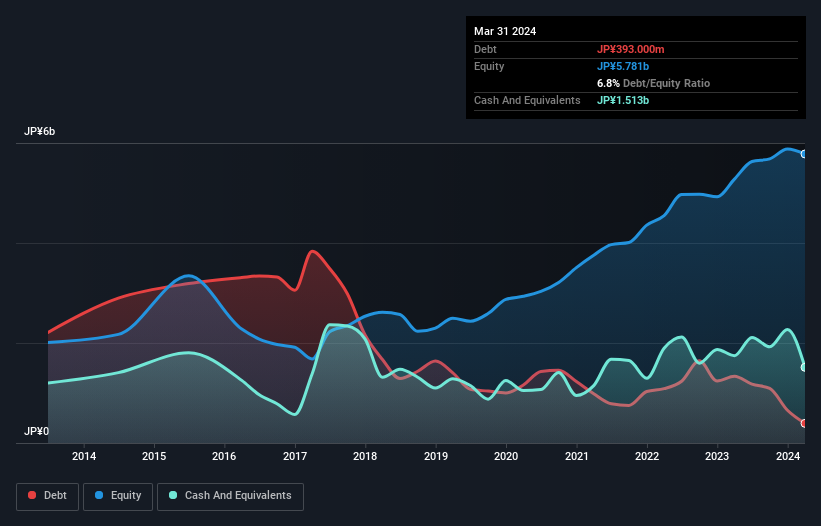
Legendary fund manager Li Lu (who Charlie Munger backed) once said, 'The biggest investment risk is not the volatility of prices, but whether you will suffer a permanent loss of capital.' It's only natural to consider a company's balance sheet when you examine how risky it is, since debt is often involved when a business collapses. We can see that Nagaoka International Corporation (TSE:6239) does use debt in its business. But the real question is whether this debt is making the company risky.
Why Does Debt Bring Risk?
Debt is a tool to help businesses grow, but if a business is incapable of paying off its lenders, then it exists at their mercy. Ultimately, if the company can't fulfill its legal obligations to repay debt, shareholders could walk away with nothing. While that is not too common, we often do see indebted companies permanently diluting shareholders because lenders force them to raise capital at a distressed price. Of course, plenty of companies use debt to fund growth, without any negative consequences. When we think about a company's use of debt, we first look at cash and debt together.
View our latest analysis for Nagaoka International
What Is Nagaoka International's Net Debt?
You can click the graphic below for the historical numbers, but it shows that Nagaoka International had JP¥393.0m of debt in March 2024, down from JP¥1.34b, one year before. But it also has JP¥1.51b in cash to offset that, meaning it has JP¥1.12b net cash.

How Healthy Is Nagaoka International's Balance Sheet?
We can see from the most recent balance sheet that Nagaoka International had liabilities of JP¥2.13b falling due within a year, and liabilities of JP¥271.0m due beyond that. On the other hand, it had cash of JP¥1.51b and JP¥3.80b worth of receivables due within a year. So it actually has JP¥2.91b more liquid assets than total liabilities.
It's good to see that Nagaoka International has plenty of liquidity on its balance sheet, suggesting conservative management of liabilities. Given it has easily adequate short term liquidity, we don't think it will have any issues with its lenders. Simply put, the fact that Nagaoka International has more cash than debt is arguably a good indication that it can manage its debt safely.
Better yet, Nagaoka International grew its EBIT by 108% last year, which is an impressive improvement. If maintained that growth will make the debt even more manageable in the years ahead. There's no doubt that we learn most about debt from the balance sheet. But it is Nagaoka International's earnings that will influence how the balance sheet holds up in the future. So when considering debt, it's definitely worth looking at the earnings trend. Click here for an interactive snapshot.
Finally, a business needs free cash flow to pay off debt; accounting profits just don't cut it. Nagaoka International may have net cash on the balance sheet, but it is still interesting to look at how well the business converts its earnings before interest and tax (EBIT) to free cash flow, because that will influence both its need for, and its capacity to manage debt. During the last three years, Nagaoka International produced sturdy free cash flow equating to 62% of its EBIT, about what we'd expect. This free cash flow puts the company in a good position to pay down debt, when appropriate.
Summing Up
While we empathize with investors who find debt concerning, you should keep in mind that Nagaoka International has net cash of JP¥1.12b, as well as more liquid assets than liabilities. And we liked the look of last year's 108% year-on-year EBIT growth. So is Nagaoka International's debt a risk? It doesn't seem so to us. The balance sheet is clearly the area to focus on when you are analysing debt. However, not all investment risk resides within the balance sheet - far from it. For example, we've discovered 3 warning signs for Nagaoka International (1 is potentially serious!) that you should be aware of before investing here.
At the end of the day, it's often better to focus on companies that are free from net debt. You can access our special list of such companies (all with a track record of profit growth). It's free.
Valuation is complex, but we're here to simplify it.
Discover if Nagaoka International might be undervalued or overvalued with our detailed analysis, featuring fair value estimates, potential risks, dividends, insider trades, and its financial condition.
Access Free AnalysisHave feedback on this article? Concerned about the content? Get in touch with us directly. Alternatively, email editorial-team (at) simplywallst.com.
This article by Simply Wall St is general in nature. We provide commentary based on historical data and analyst forecasts only using an unbiased methodology and our articles are not intended to be financial advice. It does not constitute a recommendation to buy or sell any stock, and does not take account of your objectives, or your financial situation. We aim to bring you long-term focused analysis driven by fundamental data. Note that our analysis may not factor in the latest price-sensitive company announcements or qualitative material. Simply Wall St has no position in any stocks mentioned.
About TSE:6239
Nagaoka International
Develops and sells water intake and treatment systems, and screen internals to oil refining and petrochemical industries in Japan and internationally.
Flawless balance sheet and fair value.
Market Insights
Community Narratives




